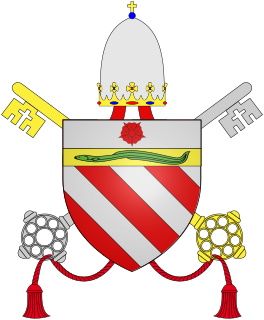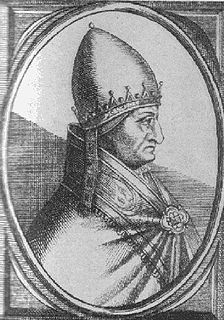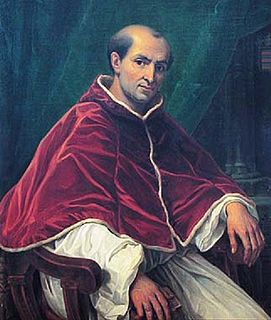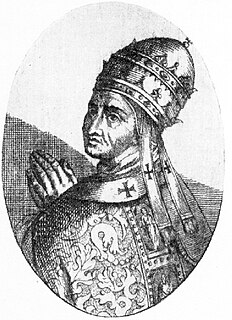
The Orsini family is an Italian noble family that was one of the most influential princely families in medieval Italy and Renaissance Rome. Members of the Orsini family include three popes: Celestine III (1191–1198), Nicholas III (1277–1280), and Benedict XIII (1724–1730). In addition, the family membership includes 34 cardinals, numerous condottieri, and other significant political and religious figures.

Pope Celestine IV, born Goffredo da Castiglione, was head of the Catholic Church and ruler of the Papal States from 25 October 1241 to his death.

Pope Nicholas III, born Giovanni Gaetano Orsini, was head of the Catholic Church and ruler of the Papal States from 25 November 1277 to his death.
Blessed Margherita Colonna, was a member of the Italian Colonna family, which was notable in Italian history for centuries. She lived as a nun, with her followers.
Orsini is a surname of Italian origin, ultimately derived from Latin ursinus ("bearlike") and originating as an epithet or sobriquet describing the name-bearer's purported strength. Notable people with the surname include the following:

Matteo Orsini was an Italian Dominican friar and Cardinal.

The papal election of 1268–71, following the death of Pope Clement IV, was the longest papal election in the history of the Catholic Church. This was due primarily to political infighting between the cardinals. The election of Teobaldo Visconti as Pope Gregory X was the first example of a papal election by "compromise", that is, by the appointment of a committee of six cardinals agreed to by the other remaining ten. The election occurred more than a year after the magistrates of Viterbo locked the cardinals in, reduced their rations to bread and water, and removed the roof of the Palazzo dei Papi di Viterbo.

Latino Malabranca Orsini was a Roman noble, an Italian cardinal of the Holy Roman Church, and nephew of Pope Nicholas III.

Bentivenga de Bentivengis, O. Min., also written Bentivegna de Bentivegni, or de Bentivenghi or Bentivegnawas, was an Italian Franciscan and cardinal.

The papal conclave of January 1276, was the first papal election held under the rules of constitution Ubi periculum issued by Pope Gregory X in 1274, which established papal conclaves. According to Ubi periculum Cardinals were to be secluded in a closed area; they were not even accorded separate rooms. No cardinal was allowed to be attended by more than one servant unless ill. Food was to be supplied through a window; after three days of the meeting, the cardinals were to receive only one dish a day; after five days, they were to receive just bread and water. During the conclave, no cardinal was to receive any ecclesiastical revenue. These provisions were regularly disregarded, at the discretion of the cardinals, particularly the requirement of being incommunicado.

The papal election of 1287–88 was the deadliest papal election in the history of the Roman Catholic Church, with six of the sixteen cardinal electors perishing during the deliberations. Eventually, the cardinals elected Girolamo Masci, O.Min. as Pope Nicholas IV, almost a year after the death of Pope Honorius IV, who died on April 3, 1287. Nicholas IV was the first Franciscan pope.
Matteo Rosso Orsini (1178–1246), called the Great, was an Italian politician, the father of Pope Nicholas III. He was named senatore of the City of Rome by Pope Gregory IX in 1241: in this capacity he took a firm stand against the ventures in Italy of Frederick II, Holy Roman Emperor, and defeated him in 1243.

The papal conclave of 1294 was convoked in Naples after the resignation of Pope Celestine V on 13 December 1294. Celestine V had only months earlier restored the election procedures set forth in the papal bull Ubi periculum of Pope Gregory X, which had been suspended by Pope Adrian V in July 1276. Every papal election since then has been a papal conclave. It was the first papal conclave held during the lifetime of the preceding pontiff, an event not repeated until the papal conclave of 2013 following the resignation of Pope Benedict XVI.

The papal conclave of 1304–05, held in Perugia, was the protracted papal conclave that elected non-cardinal Raymond Bertrand de Got as Pope Clement V. This immediately preceded the beginning of the Avignon Papacy.
Napoleone Orsini may refer to several members of the Orsini family:
Napoleone Orsini was a Roman Cardinal. His ecclesiastical career lasted 57 years, 54 of them as a cardinal, and included six conclaves.

The papal conclave of 1303 elected Pope Benedict XI to succeed Pope Boniface VIII.
Giovanni Gaetano Orsini, Cardinal of the Holy Roman Church from 17 December 1316 until his death, was a Roman nobleman, a nephew of Pope Nicholas III and a grandson of Matteo Rosso Orsini.
Giordano Orsini was a Roman nobleman of the 14th century. Exponent of the powerful Orsini family, he was son of Matteo Rosso II Orsini, and because of that nephew of Pope Nicholas III and of cardinal Giordano Orsini. Senatore of Rome in 1341 together with Orso dell'Anguillara, on 8 April of that year they bestowed the laurel crown to Francesco Petrarca on the Capitoline Hill. During the revolutionary attempt of Cola di Rienzo, he favoured the tribune, unlike the rest of the Roman nobility. Chief of the Montegiordano line of the family, he possibly gave the name to this Roman hill.

Matteo Rosso Orsini, was a Roman aristocrat, politician, diplomat, and Roman Catholic Cardinal. He was the nephew of Pope Nicholas III (1277-1280).












